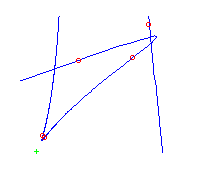

Next: 5.2 Quintics with 7 flexes and
one cusp
Up: 5. Maximally Inflected Quintics
5.1 Maximally Inflected Quintics With 9 Flexes
Here, we draw all the rational plane quintics with 9 flexes at the points
-8, -5, -2, -1, 1, 2, 5, 8, and infinity.
There are 42 such curves in all.
However, since the set of ramification points is fixed under the involution
that sends s to -s, we may reparameterize any such curve
(reversing the direction of parameterization) to obtain another.
This either gives the same parameterized curve back (up to fractional liinear
transformation in the plane), or it gives a different curve.
The images of the original curve and the reparameterization, as
unparameterized curves in the plane are identical.
An artifact of the method we use for drawing such curves is that the
reparameterized curve is the image of the original curve, reflected about
some vertical axis.
Thus the curves which equal their reparameterization are symmetrical while
those which do not are assymetrical.
Altogether, there are 6 symmetrical curves and 36 assymetrical curves
with this choice of ramification.
(In fact, this decomposition of 6 and 36 persists for any similar symmetric
(under s maps to -s) choice of the 9 points of ramification.
Below, we display the 42 curves.
We mark the positions of the flexes by red circles.
Some curves have only 8 flexes displayed; the 9th flex is on the line at
infinity,
We indicate the positions of the solitary points by
green crosses.
Some curves have a yellow line
those curves have a pair of complex nodes, and the
yellow line is the real line on which the complex
conjugate nodes lie.
Lastly, the MAPLE files used to draw these pictures are found in the
subdirectory 9flexes.maple/.
Consider first the curves with three solitary points.
There are 2 symmetric such curves and 5 pairs of assymmetric curves,
for a total of 12 curves with 3 solitary points.
The two first curves
are symmetric.
The one on the right
has two flexes at
its `nose'. |
 |
 |
Next, there are
three pairs of
assymmetric curves.
These 8 curves have
three real nodes as
well as three solitary
points. |
 |
 |
The chord diagrams
of three are hexagons
while five are
asterixes.
|  |
 |
 |

Crossings in middle |
 |
There are four more
curves with three
solitary points.
These each have a pair
of complex nodes. |
 |
 |
These last two each
have two pairs of
flexes whose images
are very close. |
 |
 |
Now, we display curves with four soliary points.
There are 9 with two real nodes and 9 with
no nodes, but a complex conjugate pair of complex nodes.
There are 9 curves with five solitary points.
Such a quintic must have one crossing.
There are three curves with 6 solitary points.
One is symmetric, while two form an assymmetric pair.
None has a crossing.


Next: 5.2 Quintics with 7 flexes and
one cusp
Up: 5. Maximally Inflected Quintics












































